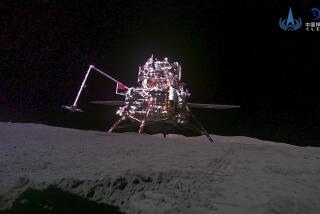Mars Curiosity rover eats first spoon of dirt in ‘promised land’
Scooping up intriguing Martian soil and casting away suspect batches, NASA’s Mars Curiosity rover has finally shoved a tiny spoonful into its robot belly to analyze, scientists at Jet Propulsion Laboratory said Thursday.
The Mars Science Laboratory rover has arrived at Glenelg Intrigue – conceptually an area where three different types of terrain meet, said project scientist and Caltech geologist John Grotzinger. The information scientists glean about the rocks here will help them decide where to finally break out Curiosity’s drill, he explained.
“We consider ourselves now to be in sort of the promised land,” Grotzinger added.
Now in its 72nd Martian day, or “sol,” roaming the Red Planet since its Aug. 5 landing in Gale Crater, the rover has spent more than a week scooping Martian soil from dunes at a spot called Rocknest. The rover would first use scoopfuls of Martian sand to clean out its sample system, removing any contaminants by sandblasting the interior.
But scientists were stumped when they saw a pale object glinting in the soil in a hole made by the scoop on Oct. 12 – one that didn’t seem to belong. They dumped the sample, fearing that the strange thing might actually be Earth material that would contaminate the sample.
This wasn’t the first time the team had come across a suspected foreign object. On Oct. 7, the team came across a strange, half-inch-long fragment that was determined to be debris from the spacecraft.
But after examining the grain, most of the team believes that the pale stuff they’re now seeing is indigenous to Mars, Grotzinger said.
Now with a fresh, problem-free sample delivered to the rover’s chemistry and mineralogy instrument, or CheMin, the Mars Science Laboratory rover will hit the soil sample with X-rays to determine its mineral structure. The sample just dumped into CheMin represents the fine-grained “dust” that’s thought to cover the Red Planet’s surface, scientists said.
“They are going to be able to analyze, finally, once and for all the mineral composition of … the stuff that swirls around the planet, and that’s why this is going to be such a cool measurement,” Grotzinger said.
They’ll also have a new target – the strange pale grains, originally a source of alarm – to analyze. The Chemistry and Camera instrument, which can shoot a laser at rock, will be able to zap the tiny grains and analyze the vaporized minerals.
The rover’s ultimate goal is Mt. Sharp, a 3-mile-high mound in the middle of Gale Crater whose layers could reveal whether Mars was ever hospitable to life.
Follow me on Twitter @aminawrite.







